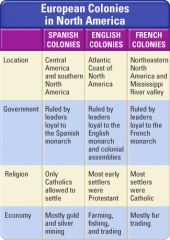![]()
![]()
![]()
Use LEFT and RIGHT arrow keys to navigate between flashcards;
Use UP and DOWN arrow keys to flip the card;
H to show hint;
A reads text to speech;
22 Cards in this Set
- Front
- Back
|
demand
|
A need or a desire for a good or service by people willing to pay for it.
|
|
|
supply
|
An amount of a good that is offered for sale.
|
|
|
ally
|
A partner.
|
|
|
proprietary colony
|
A colony owned and ruled by one person who was chosen by a king or queen.
|
|
|
How did slavery develop in the Americas?
|
Both Spain and Portugal needed many workers to grow crops and to mine gold and silver. They forced the Native Americans they had conquered into slavery.
|
|
|
Samuel de Champlain
|
Hired by a group of merchants to find a place to build a settlement. In 1608, Champlain founded Quebec along the St. Lawrence River.
|
|
|
Peter Minuit
|
Governor of New Netherland by 1626. During this time, the Dutch believed they had bought Manhattan Island from the Native Americans who were living there.
|
|
|
Jacques Marquette
|
A Catholic missionary who set out to find the Mississippi in 1673 with Louis Joliet. With help from Native Americans, they found the Mississippi.
|
|
|
Louis Joliet
|
A fur trader who set out to find the Mississippi in 1673 with Jacques Marquette. With help from Native Americans, they found the Mississippi.
|
|
|
Sieur de la Salle
|
French explorer René-Robert Cavelier (ka•vuhl•YAY), known as Sieur de la Salle, set out to find the mouth of the Mississippi River. In 1682, La Salle led an expedition that traveled south from the Illinois River
|
|
|
Louisiana
|
In 1682, La Salle claimed all of the Mississippi River valley for France. He named the region Louisiana in honor of King Louis XIV.
|
|
|
Quebec
|
The first French settlement in North America.
|
|
|
New Netherland
|
Duth built settlements along the Hudson River, in parts of what are now New York and New Jersey.
|
|
|
New Amsterdam
|
Dutch a town on the south end of Manhattan Island in 1626. They called the settlement New Amsterdam, after the city of Amsterdam in the Netherlands. New Amsterdam was built next to a harbor where the Hudson River flows into the Atlantic Ocean.
|
|
|
New Sweden
|
In 1638, Swedish settlers founded the colony of New Sweden to the south of New Netherland. New Sweden included parts of present-day Pennsylvania, New Jersey, and Delaware.
|
|
|
New Orleans
|
In 1722, New Orleans, one of the Louisiana colony´s first towns, became Louisiana´s capital. Settlers built levees, or earthen walls, to protect the low-lying town from floodwater.
|
|
|
New France
|
Land claimed by the French in what are today Canada and the northeastern United States
|
|
|
Why did New France grow slowly?
|
Most French people were not interested in moving to North America.
|
|
|
How did conflicts with the Dutch affect Native Americans in New Netherland?
|
By the late 1630s, conflicts with the Native Americans had grown because the settlers had cleared more land for farms. The colonists and the Native Americans attacked each other´s farms and villages. The colonists then sent out an army that destroyed Native American villages all over New Netherland.
|
|
|
John Law
|
In 1717, John Law, a Scottish banker, became Louisiana´s owner. Law started a company to build plantations and towns. He also brought in thousands of new settlers.
|
|
|
Why was it hard for the French to control land in North America?
|
Louisiana failed to attract many people. By 1763, there were only 80,000 French colonists living in North America.By the same year, there were more than 1,500,000 English colonists in North America.
|
|
|
Compare the Spanish, English and French Colonies.
|

|

